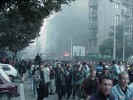"Survivor Tells of Massacre at Kosovo Village," said a May 3, 1999 New
York Times front-page headline. Anthony DePalma's lengthy story
gave a dramatic account of the killing of 58 Kosovar Albanians at Bela Crkva on March 25
(over a month past at the time of the front-page story), focusing heavily on the lingering
anguish of the survivors.
In the same day's Times, on page A14, is a brief story headlined "NATO
Admits Missile Hit Bus but Says Bridge Was a Legitimate Target." This story by Philip
Shenon reports NATO's admission that on May 1, a NATO missile hit a bus in Luzane, killing
47 Yugoslavian civilians. Shenon gives a fairly dry, straightforward
account of NATO's statements that the deaths were accidental and regrettable, but understandable because, as a NATO spokesman says, the bridge the bus
was on was "a legitimate military target."
The assertion that roads and bridges regularly traveled by
civilians are military targets was not questioned. Nor were the grieving families of the
bus passengers interviewed.
Outrage, sympathy and front-page focus for the 58 people killed a month ago by Serb
forces. Clinical regret and a minimizing page A14 for the 47 people
killed two days ago by NATO forces. The two Times stories are an extreme
though hardly unique example of the media's tendency to focus justifiable outrage on Serb
atrocities, while presenting NATO forces as principled strategists who occasionally make
mistakes.
How many mistakes? A Nexus search of the New York Times from March 23 to May 3
found that, adding up the casualties reported in various articles, the
Times has reported incidents in which a total of at least 231 Yugoslavian civilians
have been killed by NATO since the start of the bombing. (While Western journalists
have examined the sites of most of these attacks, the source for casualty numbers is
generally the Yugoslavian government; Yugoslavia claims NATO is responsible for 500
civilian deaths overall.)
Yet estimates of total civilian casualties caused by NATO in Yugoslavia since the start
of the bombing campaign have been conspicuously absent from mainstream coverage, even
considering the difficulty of gathering data during a war. NATO's persistent focus on the
"accidental" nature of the deaths is rarely questioned by the press; the
strongest criticism usually comes in discussions of the damage such "accidents"
do to NATO's PR image.
Little effort is being made by the media to hold NATO accountable for deaths that
result from attacks on targets that are mainly or entirely civilian, which would seem to
be forbidden as targets by international law. (


